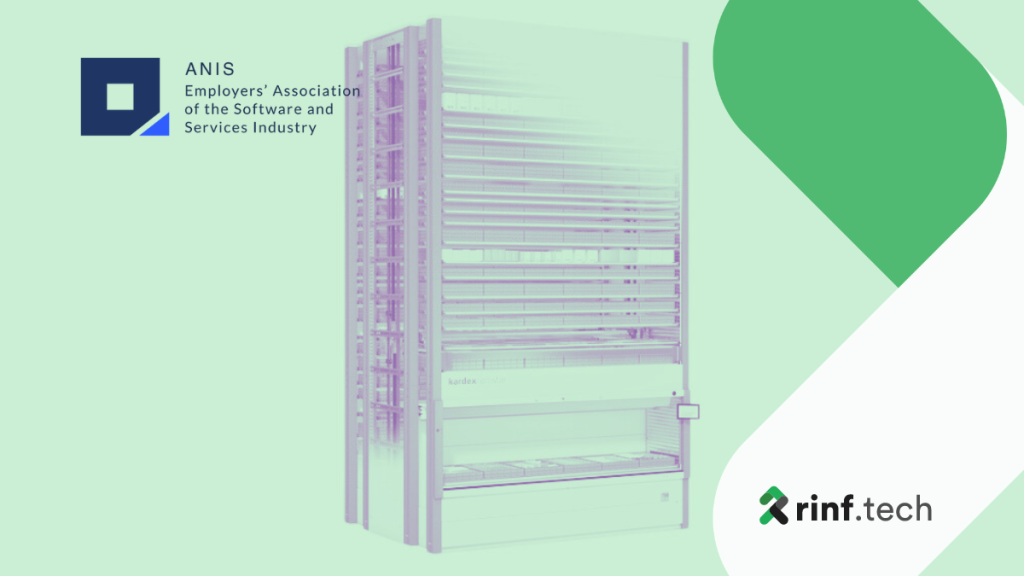The following section focuses on technology trends in 8 of the world’s most important sectors.
1. Fintech
We have heard about decentralized finance (DeFi) for years, but 2024 will see it becoming a more widespread phenomenon. Various convening factors will result in centralized institutions like banks becoming an option rather than the norm.
Furthermore, AI and ML will play a significant role in fintech. The ability to process and analyze vast amounts of customer activity and data at sub-second speeds means that financial companies can provide their customers with a more customized range of products and services. There will also be a dramatic increase in embedded finance, where more and more companies integrate banking capabilities into their applications.
Another significant trend in the world of fintech is embedded finance and how it’s expected to revolutionize the way businesses integrate financial services. Embedded finance allows companies to seamlessly incorporate banking services, such as payments, lending, and insurance, directly into their non-financial platforms. This trend is projected to gain considerable traction in 2024, creating a more integrated and user-friendly experience for customers. Businesses across various sectors will be able to offer tailored financial solutions, enhancing customer engagement and unlocking new revenue streams.
2. Retail
Like numerous other industries, ML capabilities will profoundly transform how retail businesses serve their customers. The volume of customer data that’s collected around the clock means that companies will know every intricacy of their customers’ buying behaviors. This means shopping experiences will become highly personalized, especially online. AI and ML capabilities will also help companies position their products in the most lucrative markets.
Another major trend in the retail sector is represented by Large Language Models. Large Language Models (LLMs) have the potential to significantly improve business operations and customer experiences in the retail industry in 2024. These advanced AI models can analyze vast amounts of data to provide insights into customer preferences, enabling retailers to offer highly personalized shopping experiences. LLMs can also be employed for inventory management, trend forecasting, and customer service through intelligent chatbots. Their ability to understand and generate human-like text will revolutionize how retailers interact with customers, offering more engaging and responsive communication. This integration of LLMs in retail will streamline operations and transform how customers shop and interact with brands.
The most significant change that retail will witness in 2024 is the rise in seamless multimodal shopping experiences. For example, a customer can window-shop online, use digital technologies to “try on” a product, find retail outlets nearby, and make a purchase quickly and without complications.
3. Supply Chain and Logistics
Constant supply chain automation is essential to surviving in today’s volatile markets. The most prominent technologies set to influence this sector in 2024 are Electronic Data Interchange (EDI) and Application Programming Interface (API)-driven visibility and transparency tools. Customers expect complete visibility across their supply chain, meaning the entire supply chain lifecycle needs to be accessible with the click of a mouse.
In 2024, advanced analytics and AI are expected to further optimize supply chain and logistics operations. Predictive analytics will enable more precise demand forecasting, reducing inventory costs and improving delivery times. Real-time tracking technologies, coupled with IoT devices, will offer greater transparency and efficiency in logistics operations. These advancements will lead to smarter, more agile supply chains capable of adapting to changing market demands and disruptions, thus ensuring continuous and efficient delivery of goods and services.
4. Healthcare
It’s impossible to talk about technology trends in 2024 without mentioning healthcare. The healthcare industry is always at the forefront of technological innovations but never as much as in current times. Generative AI is increasingly significant in healthcare, especially in backend administrative functions, medical contexts, and customer-facing tools like virtual chatbots and digital assistants. The future potential of generative AI in healthcare contexts will become more pronounced in the coming year.
Digital twins are another exciting technology that will come to fruition soon. Digital twins involve creating a virtual copy of a real-world entity (which can include human bodies as well as hospital infrastructure for training simulations). Other digital innovations will come in the form of VR (Virtual Reality) and AR (Augmented Reality) technologies with diverse use cases ranging from mental health to surgery. Additionally, the quality and usability of 3D models will reach a high level in 2024, meaning that everything from medical instruments to human organs can be custom-created.
The healthcare industry will also see a significant push towards personalized medicine in 2024, driven by advancements in genomics and AI. Telemedicine, augmented by AI for more accurate diagnostics and treatment recommendations, will become more prevalent. Wearable health devices will provide real-time health monitoring, allowing for proactive management of chronic diseases. These technologies will not only enhance patient care but also streamline healthcare administration, leading to a more efficient healthcare system focused on patient-centric care.
5. Energy and Utilities
The energy and utilities sector’s main technology trends in 2024 include IoT integrations and AI-powered automation. There will be a measurable rise in smart grids and energy-adjacent IoT machinery. This will help optimize performance and provide enterprises with complete real-time visibility into their energy and utilities infrastructure. Vast amounts of data will be collected from these environments so that companies can make informed, data-driven business decisions to optimize their operations.
When we think of a dangerous environment for human workers, we usually think about the energy and utilities sector. Technology can help make these environments a safer place. The introduction of automation can ensure that machines rather than humans can handle repetitive and unsafe tasks. This can improve efficiency and safety and free up workforces to do more human-centric tasks. Other technology trends in energy will include the acceptance of blockchain architectures, the adoption of DeFi services, and the maturing of sustainability initiatives.
The energy sector will also focus on sustainable and smart energy solutions in 2024. AI and IoT will be crucial in optimizing energy usage and managing resources efficiently. Integrating renewable energy sources into the grid, supported by advanced battery storage technologies, will accelerate the transition to cleaner energy. Smart grids, enabled by AI, will facilitate real-time energy management and distribution, ensuring reliability and sustainability in energy supply.
6. Semiconductors
The semiconductor industry will be a prominent recipient of new and advancing technologies in 2024. According to Gartner, the revenue of semiconductors that are made to deploy AI workloads will rise by more than 25% in 2024 and total more than $67 billion. In the next three years, this revenue will likely reach almost $120 billion, making 2024 a crucial juncture in the growth journey of this mammoth industry.
The primary technologies that will benefit the semiconductor industry include AI, ML, and IIoT (Industrial Internet-of-Things) machinery. Parallel advancements in other industries will have significant implications for the semiconductor sector. For instance, the booming automotive, healthcare, manufacturing, and smart agriculture industries will create a massive demand for semiconductors, catalyzing many technological shifts in the next year.
We will also see continuous innovations, focusing on developing more powerful and energy-efficient chips. With the increasing demand for high-performance computing and AI applications, advancements in semiconductor technology will be critical. Integrating AI in chip design will lead to faster and more efficient production processes. These developments will drive the next wave of technological advancements in various fields, including consumer electronics, automotive, and industrial applications.
7. Manufacturing
2024 will see an increase in smart factories, which is no surprise considering the smart factory market will likely reach a value of more than $140 million by 2027. The technologies associated with smart factories include edge computing, cloud services, AI-powered ML capabilities and analytics, and the rise in IIoT equipment. These technologies will help manufacturing enterprises improve efficiency, increase uptime, optimize costs, leverage their data to its fullest potential, and nurture transparent and seamless factory environments.
Remember that embedded systems development will power this next chapter in the manufacturing story. Embedded development, the secret behind Industry 4.0, involves the seamless amalgamation of software and hardware to serve a particular context – in this case, manufacturing. Embedded systems development can help enhance smart factories, optimize data pipelines, drive sustainability initiatives, and harden cybersecurity posture. Embedded systems development can help organizations edge past competitors and dominate incredibly crowded sectors like manufacturing.
Another major trend in the manufacturing sector in 2024 will be towards increased automation and intelligent manufacturing. AI and robotics will be extensively used to enhance production efficiency and flexibility. Implementing digital twins – virtual replicas of physical systems – will enable real-time monitoring and predictive maintenance, reducing downtime and improving product quality. These technologies will transform traditional manufacturing processes, leading to more resilient and adaptive manufacturing systems that respond quickly to market changes.
8. Transportation
In 2024, the transportation industry will witness significant fleet automation and management advancements. Integrating AI and IoT technologies in fleet operations will enable more efficient route planning, vehicle maintenance, and fuel management. Automated fleet management systems will reduce operational costs and enhance safety and reliability. These systems will provide real-time data analytics, allowing for swift decision-making and fleet performance optimization. This trend represents a shift towards smarter, more connected, and automated fleet operations, crucial for meeting the increasing demands of modern transportation logistics.
Another trend, Cloud CCTV surveillance in transportation is set to redefine security and monitoring operations. This technology enables remote and real-time monitoring of vehicles and infrastructure, ensuring enhanced safety and security. Cloud-based surveillance systems offer scalable storage, more accessible access to footage, and advanced analytics capabilities. In 2024, these systems will become integral in monitoring traffic patterns, detecting anomalies, and preventing potential security threats. The shift to cloud-based surveillance represents a move towards more proactive and data-driven transportation safety and security management approaches.







